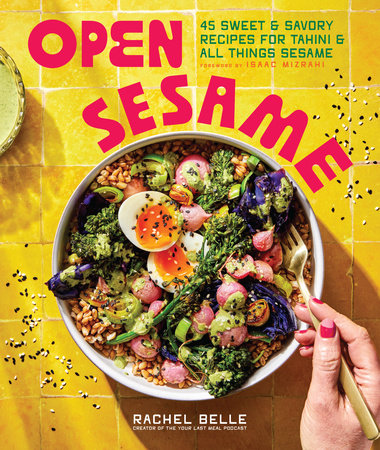IntroductionBe honest. Have you ever finished an entire jar of tahini? How many times have you bought tahini for, say, a hummus recipe or a salad dressing, used ¼ cup and then watched it slowly migrate to the back of the refrigerator, unsure of what to do with the rest? *slowly raises hand*
Here at
Open Sesame we believe in No Tahini Left Behind!
Like a little black dress, tahini can seamlessly transition from day to night, from savory to sweet, from the Middle East to the Midwest, with a healthy drizzle baked into your morning granola, poured over Pita Chip Nachos (page XX) in the form of creamy Tahini Feta Queso (page XX) and, for dessert, Chocolate Miso Whoopie Pies with Tahini Cream (page XX). Tahini: it’s not just for hummus! But we’ll show you how to make a fantastic version of that, too.
This book is a celebration of sesame in its many forms: the distinct, earthy warmth of sesame oil bobbing on the surface of a noodle soup, the toasty crunch of a sesame seed crusted mushroom schnitzel, and the deep, dark nuttiness of black sesame paste blended with dates, banana, and milk.
But the origin story of this book is rooted in a Tahini Epiphany
™. Growing up in the 1980s with an Israeli-raised dad, my family ate a fair amount of chhhoumoose. That’s how we pronounce hummus—the Hebrew way—with the signature guttural, phlegm clearing roll in the back of the throat (she’s one page into her cookbook and she’s already said
phlegm?). Chhhhhouuumouuuse! This was before “hummus” was a household name, before you could buy seven varieties (pumpkin spice hummus! chocolate hummus!) at Trader Joe’s. This was before
we’d ever
heard of
Trader Joe’s!
Hummus is simple: a blend of chickpeas, tahini, lemon, garlic, ice water, and salt. But every time I made a batch in my own kitchen, it never tasted quite right. I tried everything: tirelessly peeling the skins off every single garbanzo bean, soaking dried beans in baking soda-spiked water. The hummus I ordered in restaurants, or bought from the supermarket, wasn’t any better.
One night, after a performance at the Mercer Island, Washington JCC, the audience was treated to a Middle Eastern nosh. I halfheartedly scooped an obligatory blob of paprika-dusted hummus onto my tiny plate, dragged a wedge of pita through it and, reader, I immediately lost my mind.
“Who made this hummus!?” I squawked, interrupting groups of kibbitzing strangers with my broken record question. This was it! The flavor I’d been chasing for over a decade! I was given the phone number of the caterer, an Israeli man my father’s age, and the next weekend I was standing in Eli Lahav’s kitchen watching him make chhhoumoose.
He cranked open a giant can of chickpeas from a restaurant supply store, glugged an ungodly amount of tahini into the food processor, and after a single taste it became clear: delicious hummus relies completely on delicious tahini! I needed better tahini and lots of it.
Not long after, I interviewed the chef-owner of Seattle’s Aviv Hummus Bar for my podcast,
Your Last Meal. Aviv serves life-changing hummus, the best I’ve tasted outside Israel, and although he wouldn’t share the brand of tahini he uses, he gave me a clue: it must be made in Israel.
A shipment of Har Bracha tahini later, I stood in my kitchen in disbelief: I did it! I finally made the good hummus! I have since become a tahini evangelist: sending friends home with my favorite brands, typing up and emailing out my hummus recipe, and bringing it to potlucks. And now (mwahaha) I have an entire book to proselytize!
But this book is so much more than hummus, or even Middle Eastern cuisine! Tahini is your plant-based ticket to creaminess, an understudy for peanut butter when allergies are at play and its mild nuttiness was destined for desserts.
Sesame is one of the most ancient ingredients, eaten by humans for thousands of years. Grown in Asia, Africa, and South America, and exported around the world, it finds its way into the kitchens of many, many cultures.
In
Open Sesame, we’ll explore some well-known Asian and Middle Eastern applications for sesame, get creative with takes on Mexican and Indian dishes and sprinkle sesame on some American classics.
Not All Tahini Is Created Equal!Tahini is made from a single ingredient: toasted sesame seeds. That’s it! Just roasty toasty, teeny tiny sesame seeds ground down to a silky, beige, peanut-buttery paste. No salt. No added oil. Just sesame.
But each brand of tahini can taste quite different depending on where the sesame seeds were grown, what variety they are, if they’re hulled (creamy and mild) or unhulled (gritty and bitter), how deeply they’re roasted and how many months (or years!) that jar has been languishing on the shelf. Unfortunately, you rarely see any of that information on the label!
But choosing a good tahini is important! A bitter tahini can muck up a dish (especially in hummus and sauces where the tahini is front and center) and trick you into thinking the recipe is to blame.
So how
do you choose a tasty tahini? Allow me to tahinisplain you:
· White Humera sesame seeds, grown in the northwest corner of Ethiopia, are considered the world’s best. All Israeli tahini (or
tahina) is made from Humera seeds and when I researched where my favorite brands of tahini were made, coincidentally they were
all from Israel! Turkey, Jordan, and Saudi Arabia are also importers of Humera sesame, but it’s unclear if all their tahini is made with it.
· Shop at a Middle Eastern or international market. If you love to cook, you probably love taking field trips to foreign grocery stores! While mainstream supermarkets
can carry good tahini, you’ll find a larger variety at a specialty store. Choose a couple bottles of tahini, from different countries, and see what you like! If you don’t have a market in your area, order popular brands online (my suggestions are below).
· Check the expiration date! This might sound obvious, but I recently came home with one expired jar of tahini and another that had been bottled more than a year before (it wasn’t technically expired, but definitely not fresh). Next time I’ll take my own advice!
· Fresh tahini should be easy to stir! If you’re struggling with claylike clumps or a thick layer of murky oil, it’s probably past its prime. If the tahini is clumpy, but still tastes good, scrape it into a food processor and blitz it back to silky smoothness.
· I’m loving the squeeze bottles of tahini. While it doesn’t affect flavor, having the ability to shake a bottle (no stirring!) and squirt tahini directly onto my waffles (recipe on page xx) or into a tablespoon has me reaching for the tahini far more often.
My Favorite TahinisHar Bracha
Soom (their dark chocolate tahini with sea salt is swoonworthy!)
Mighty Tahini
Haddar by Baracke
Seed & Mill
Tahini Tips· Tahini + cold water sitting in a tree! The best way to thin tahini into a sauce or a dressing is with cold water. Tahini tends to seize up when blended, but the cold water smooths it right out. Add a little at a time until you get the texture you want.
· Mix your tahini well before each use!
· Store open jars of tahini in a cool, dark place or in the fridge.
· If you’re left with a small amount of tahini at the bottom of a jar, make a dressing or sauce by adding your other ingredients directly into the jar and shaking vigorously.
Copyright © 2024 by Belle, Rachel. All rights reserved. No part of this excerpt may be reproduced or reprinted without permission in writing from the publisher.















